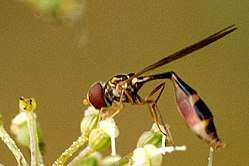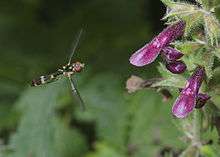Baccha elongata
| Baccha elongata | |
|---|---|
| Baccha elongata. Dorsal view | |
 | |
| Female, side view | |
| Scientific classification | |
| Kingdom: | Animalia |
| Phylum: | Arthropoda |
| Class: | Insecta |
| Order: | Diptera |
| Family: | Syrphidae |
| Genus: | Baccha |
| Species: | B. elongata |
| Binomial name | |
| Baccha elongata (Fabricius, 1794) | |
| Synonyms | |
Baccha elongata is a species of hoverfly (or flower fly) in the genus Baccha.[1]
Distribution and habitat
Baccha elongata is present in most of Europe [2] and in North America. Common and widely distributed throughout Britain and Ireland wherever there is suitable habitat though easily overlooked due to its unobtrusive nature. These hoverflies inhabit coniferous and deciduous forests, woodland, hedgerows, scrub and gardens Generally they prefer shady places low to the ground.[3][4]
Description

Baccha elongata can reach a length of 7–11 millimetres (0.28–0.43 in).[4] It is one of the smaller hoverflies, the wing length is around 4.5 to 8 mm.[5]
The long, very slender body of these hoverflies is unmistakable.[5] They also differ from other hoverflies by their elongated, thin abdomen ending in club. This club-shaped abdomen is black with a yellow spot on the 3rd and 4th segments. Legs are brownish yellow. Forehead is brightly hairy.
Members of the eristaline genus Sphegina are also very slender and can be found in similar habitat but those flies have a rather different enlarged hind femur, whereas in Baccha this feature is slender.[5] As with most hoverfly species the sexes can be told apart by the male's eyes meeting on the top of the head, but separated in the female.
This species is very similar to Baccha obscuripennis Meigen, 1822.
Biology
Adults can be seen on the wing from spring until autumn, in two generations (April/June and July/September or October).[6] They mainly feed on pollen and nectar of Compositae, Rosaceae (Alchemilla xanthochlora), Apiaceae (Angelica sylvestris, Heracleum sphondylium) and Hedera species.[3][4]
As with most other members of the subfamily Syrphinae the larvae are predatory though there seems to be a preference for a variety of different ground-layer aphids.[4][6] This species overwinters as a larva.
Bibliography
- Ball, S.G.; Morris, R.K.A. (2000). Provisional atlas of British hoverflies (Diptera, Syrphidae). Monks Wood, UK: Biological Record Centre. pp. 167 pages. ISBN 1-870393-54-6.
- Morris, Roger K. A. (1999). Hoverflies of Surrey. Surrey Wildlife Trust. p. 244. ISBN 0-9526065-3-4.
- Speight, M.C.D. (2011). "Species accounts of European Syrphidae (Diptera)" (PDF). Syrph the Net, the database of European Syrphidae. 65: 285pp.
- Stubbs, Alan E.; Falk, Steven J (1983). British Hoverflies: An Illustrated Identification Guide (2nd ed.). London: British Entomological and Natural History Society. pp. 253, xvpp. ISBN 1-899935-03-7.
- Van Veen M.P. Hoverflies of Northwest Europe, Identification Keys to the Syrphidae. — Utrecht: KNNV Publishing. — P. 254. — ISBN 9050111998
References
| Wikispecies has information related to Baccha elongata |
| Wikimedia Commons has media related to Baccha elongata. |
- ↑ BioLib
- ↑ Fauna europaea
- 1 2 Speight, M.C.D. (2011). "Species accounts of European Syrphidae (Diptera)" (PDF). Syrph the Net, the database of European Syrphidae. 65: 285pp.
- 1 2 3 4 J.K. Lindsey Commanster
- 1 2 3 Stuart Ball, Roger Morris Britain's Hoverflies: A Field Guide, Revised and Updated Second Edition
- 1 2 Nature Spot